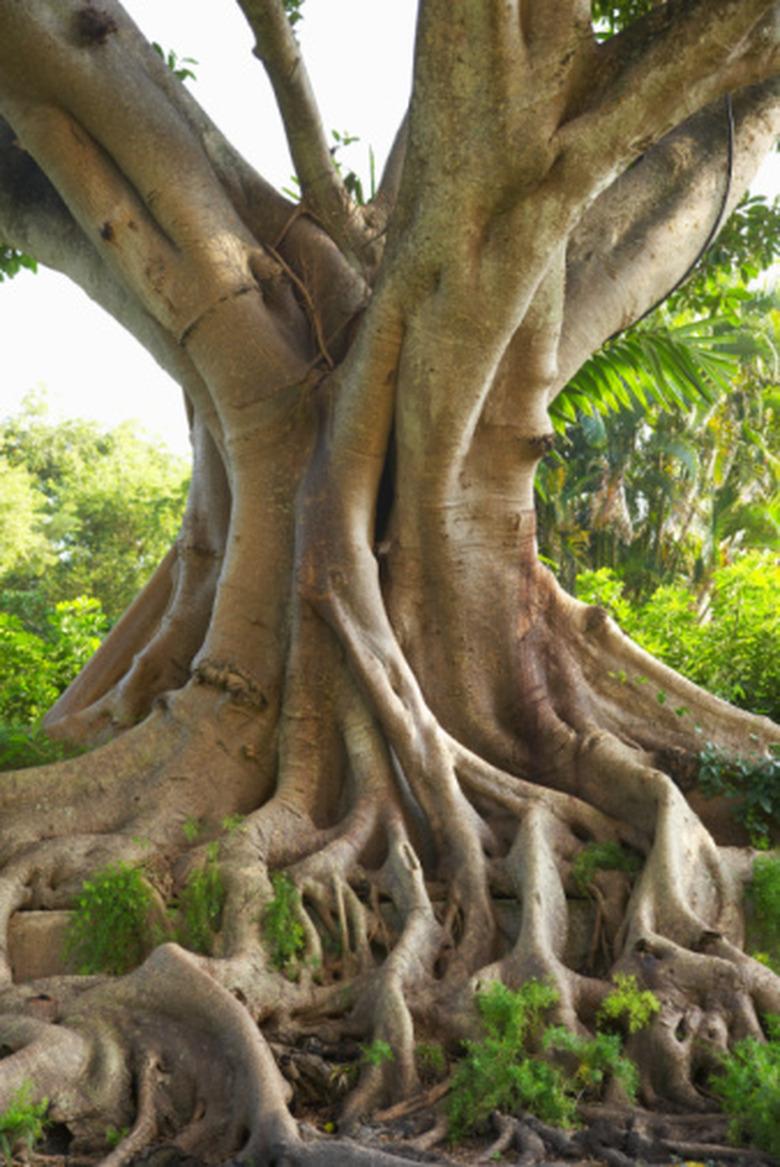How Long Does Ficus Take To Grow?
Ficus, or fig trees, are fast-growing subtropical and tropical climate trees. They are also grown as shrubs, bushes and indoor houseplants. Exact growth rates differ greatly from species to species and site to site, but healthy, fast-growing trees usually reach 25 feet within 10 years. To maintain a ficus tree's rapid growing nature, provide it with warm temperatures, adequate water, sufficient light and room to grow. House ficus plants can be maintained at their current size through potting techniques and root pruning.
Commercially Grown Ficus
Ficus originated in India and western Africa where it has been cultivated and grown for hundreds of years. Many cultivars have emerged from this period of intense production and these cultivars are grown commercially throughout the world where warm climates dominate. Cultivars such as Smyrna, Brown Turkey and Celeste are grown in the United States. Fig trees frequently produce two harvests per season. Their period of high productivity lasts for 10 to 15 years, though the trees' life spans are much longer.
Ornamental Ficus
Indoor houseplants don't bear edible fruit. Instead, indoor ficus are used for ornamentation due to their variegated leaf patterns and foliage shapes. Ficus benjamina is often found in indoor public spaces where it grows in pots or large concrete containers. Left to their own devices, outdoor ficus trees can grow up to 70 feet tall and 70 feet wide in less than 40 years. Indoor ficus, due to space limitations, will not reach these heights. When your indoor plant appears lackluster and leaves yellow or wilt then you may need to repot the plant or control its growth through both root and shoot pruning. To retard growth, many indoor growers cut back the plant's roots. Both indoor and outdoor growers prune their ficus branches annually. By regularly pruning both roots and shoots, your indoor ficus will remain the same size and in good health for years.
Growing Conditions
In the United States, ornamental ficus are grown outdoors in southern Florida, California and Hawaii. The tree is tolerant of a wide range of soils from clay to sand. It is also drought tolerant. When growing these trees indoors, it is best to maintain an environment similar to the one they experience outdoors. Some varieties, like the rubber tree ficus, tolerate low light conditions, but for your ficus to grow well, it should receive at least four hours — preferably six — of bright, indirect light per day. Avoid extreme temperature changes and keep your plant away from drafts. Allow your plant to dry out between waterings. Leaving your ficus in consistently moist soils will make it susceptible to mites, borers and other insect infestations. Moist soils also encourage fungal growth and mold, all of which inhibit growth in unhealthy ways.
Considerations
Ficus trees are grown as bonsai and are considered good plants for beginners because of their rapid growth. Once trimmed, healthy ficus exhibit new growth within three to four weeks. Their rapid growth and visible root systems allow beginners the chance to make pruning mistakes as well as to experiment with different shapes and designs.
References
- Purdue University Department of Horticulture; Fig; J. Morton; 1987
- University of Florida IFAS; Ficus Benjamina; Edward F. Gilman, et al.
- University of Minnesota Extension; Rubber Trees, Weeping Figs and Other Friendly Ficus; Deborah Brown
- Iowa State University; How Fast Do Trees Grow?; Sherry Rindels; 1995
